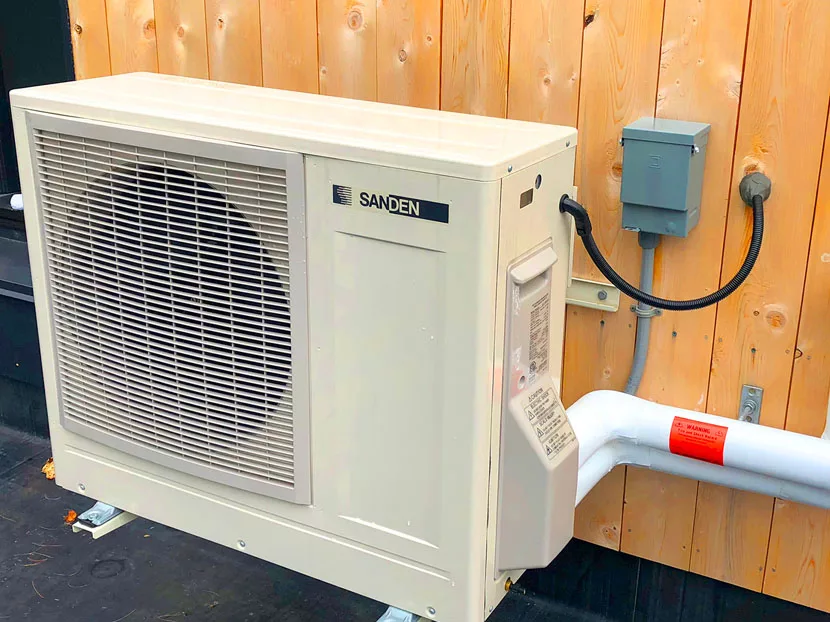Innovators are sometimes punished by the marketplace because they are too visionary and, therefore, too early. Just a few years ago, GE introduced a highly efficient heat pump water heater (HPWH) but took it off the market due to lack of sales. But in 2018, sales of these kinds of units were growing at more than 8 percent in North America and more than 11 percent globally, report research companies Research and Markets and Technavio, respectively. This growth rate is expected to continue for the next five years, at least. Most of the major manufacturers now offer an HPWH or will soon.
Heat pump water heaters usually contain one or more backup elements and offer several operating modes. The Vortex from A. O. Smith provides the efficiency mode for normal high-performance heating (heat pump only); hybrid mode, which gets support from the elements for quick recovery following increased hot water usage; electric mode, using the elements only when limited ambient heat is available; and vacation mode, which maintains tank temperature at 60 F during vacation or extended absence to reduce operating costs and provide freeze protection.
In all situations, it is recommended that HPWH units are not located in closets because they remove heat and some moisture during operation. This makes this style less ideal from an energy standpoint in a heat-dominant setting (still positive when considering greenhouse gases). HPWH are well-suited to warm climates such as Austin, Texas, where they can contribute to cooling. And they save energy during the other seasons in northern places.
The U.S. Department of Energy’s Consortium for Advanced Residential Buildings (CARB) quantified the in-situ performance of HPWHs, which rely on the vapor compression cycle to exceed the efficiency of a traditional electric resistance water heater. They monitored 14 units from A. O. Smith, GE and Stiebel Eltron, and found energy savings of between 36 percent and 63 percent. And this study was done back when they were first introduced.
Due to these kinds of findings and the capabilities of heat pump technology, federal appliance efficiency standards that went into effect in 2015 require larger electric tank water heaters to use significantly less energy. Requirements went from about 90 percent efficiency to nearly 200 percent. Manufacturers say today’s HPWHs now offer co-efficiencies of performance as high as 4.0 or 5.0, even in cold winter settings such as Vermont, Maine and Canada.
Efficiency Maine, a trust overseen by the Maine Public Utilities Commission, offers a $750 mail-in rebate on heat pump water heaters. “Given an estimated price of $1,300 for a heat pump water heater, that makes the net price for a unit around $550,” the organization notes. “Energy savings in just the first two years of use could cover that cost. And many heaters come with a 10-year warranty.”
Rescuing Vermont Restaurant
At a full-service restaurant in Bennington, Vt., it seems as if it feeds half the town each evening, completing about 300 transactions at dinnertime. To be a going concern in the modern day, restaurants have to do more than attract customers. They also have to try to control costs. When the liquid propane bill for hot water became too much, the Bennington operator began looking at options.
The answer came in the form of two heat pump water heaters and two 43-gal. storage tanks. The new system is saving the restaurant 55 percent to 60 percent compared to its previous water-heating set-up, and it also adds a bit of cooling for the kitchen team, making workers happier and more productive. The restaurant now saves about $13,500 each year on water-heating costs.
The restaurant installed Sanden International technology, which uses a split configuration with an outdoor unit to avoid cannibalizing heat energy. Sanden also uses C02 as a refrigerant, making it a completely modern solution.
“The great thing about C02 is that it doesn’t matter what the outside temperature is,” said John Miles, General Manager of Eco Systems at Sanden. “It can deliver the same capacity. However, on the coldest days, recovery time is longer. This isn’t something seen by the customer, but it’s worth noting.”
This aspect sometimes results in standby losses, but Sanden doesn’t seem to be suffering.
As of 2017, Sanden’s heat pump technology had the highest DOE Energy Factor rating in the United States at 3.84. It achieves a coefficiency of performance of 5.2 (at 67 F ambient temperature), heats water above 170 F, performs at -20 F, and is pretty quiet at just 37 decibels. Sanden technology is being used all over the country in single-family homes and larger projects.
It’s at work in hot climates such as the 26 units being used by 93 apartments in Fresno, Calif. Since 2017, they have shown a 75-percent reduction in energy for hot water. In a school cafeteria in Mobile, Ala., two conventional 80- and 120-gal. water heaters were replaced in 2016 by a Sanden heat pump and an 83-gal. tank. The school serves between 750 and 1,000 meals each day and now uses just 8.6 kilowatt /hours of power for hot water.
Cool Climate Performance
Cool climate locations include a mountain retreat in Truckee near Lake Tahoe, in the mountains between Nevada and California. Jose Rivera, a longtime Bay area net-zero house designer, moved his young family up there and installed a Sanden, writing on his blog: “The question is inevitably ‘But will it work in the winter?’ — and the answer is yes!”
Perhaps the most telling tests are two projects in Toronto and Guelph, in Ontario, Canada. One is a 53-unit affordable housing building and one is a detached home. They are both being built to the passive house standard and, in both cases, the Sanden units will also supply space heating.
This is possible with a hydronic coil producing between 10,000 and 14,000 BTUs per hour. It must be stressed that Sanden units would not likely be capable of providing enough space heat in a code-built house but the super-insulated passive house standard is more demanding than net-zero, reducing loads by 80 percent to 90 percent.
Two net-zero projects in Ontario have prominently incorporated Rheem HPWHs. In both a multi-unit, four-story condominium building and in a detached house that was part of a government net-zero pilot test, designers decided to locate the units in the solar panel inverter room. This had the effect of avoiding heat cannibalization, helping to keep inverters cool and potentially extending the life of the equipment.
Electrified House in the UK
Heat pump water heaters are also made in the United Kingdom by a firm called Earth Save Products. Company principal Harold Wilson describes a four-bedroom house in which it installed its air-source heat pump for under-floor space heating, plus its Ecocent HPWH and a heat recovery ventilator (HRV). They installed solar PV panels on the roof.
The air-source heat pump runs at 95 F, maximizing efficiency. The HPWH consumes 640 watts when heating water. It was integrated with the HRV, designed into a single ducting infrastructure, recovering some heat from ventilated air. Operating costs for the home are under US $400 per year, including heating, hot water, ventilation, lighting and cooking. Wilson says this equates to about one-third of the operating costs for a conventional UK home.
Despite these success stories, heat pump water heaters might not always be the answer — and they’re not cheap. However, they have come down a little in price, have improved performance and are a favorite candidate for incentives from governments and utilities. The reason might be that governments in both the United States and Canada undertook research studies to verify the claims that the water heaters would reduce greenhouse gas and save energy.
Matt Risinger of Risinger Homes in Austin, Texas, replaced a 13-year-old electric water heater with a Rheem HP-50 a few years ago. He reported that it was more expensive, at about $1,550 plus installation. But its annual operating cost is potentially less than half, around $234, when operated in the Energy Saver mode (heat pump heating 100 percent of water) versus $520 for a standard 50-gal. electric water heater.
At the time, the U.S. federal tax credit was at about $1,500, making it a very smart decision. Tax credits are less now, but still worth considering.
As more buildings use this technology, it looks as if GE was just too much of an early adopter. The time has finally come for greener cleaner buildings — and heat pump water heaters.





